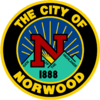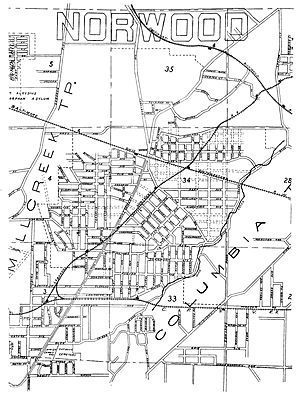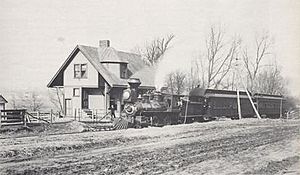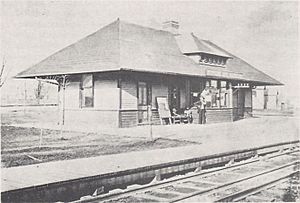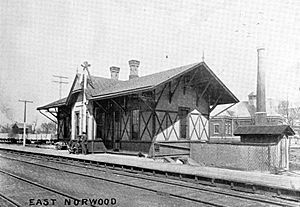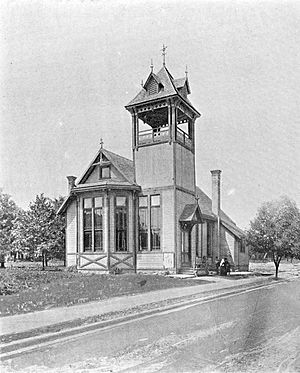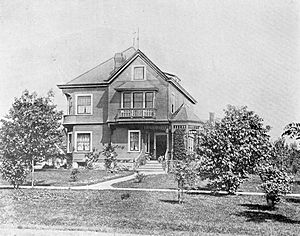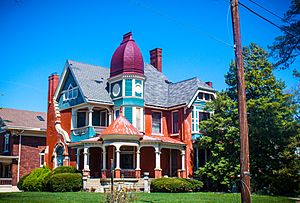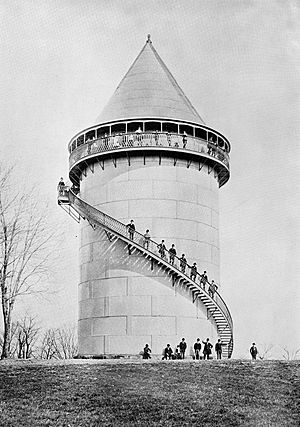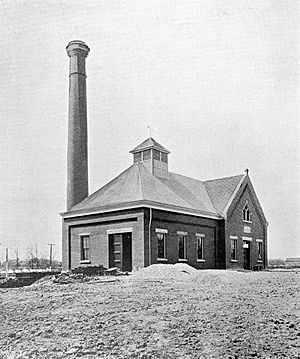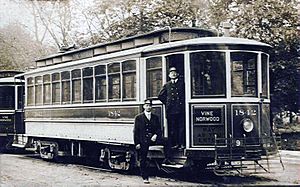Norwood, Ohio facts for kids
Quick facts for kids
Norwood, Ohio
|
|||
|---|---|---|---|
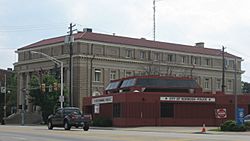
Norwood Police Department and Norwood Municipal Building on Montgomery Road
|
|||
|
|||
| Nickname(s):
Gem of the Highlands
|
|||
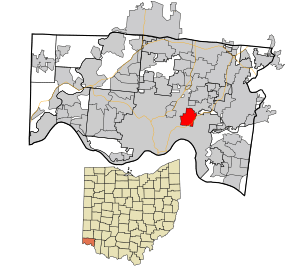
Location in Hamilton County and the state of Ohio
|
|||
| Country | United States | ||
| State | Ohio | ||
| County | Hamilton | ||
| Area | |||
| • Total | 3.14 sq mi (8.14 km2) | ||
| • Land | 3.14 sq mi (8.14 km2) | ||
| • Water | 0.00 sq mi (0.00 km2) | ||
| Elevation | 656 ft (200 m) | ||
| Population
(2020)
|
|||
| • Total | 19,043 | ||
| • Estimate
(2022)
|
19,108 | ||
| • Density | 6,058.86/sq mi (2,339.33/km2) | ||
| Time zone | UTC−5 (Eastern (EST)) | ||
| • Summer (DST) | UTC−4 (EDT) | ||
| ZIP codes |
45212, 45207
|
||
| Area code | 513 | ||
| FIPS code | 39-57386 | ||
| GNIS feature ID | 1056460 | ||
| Website | http://www.norwood-ohio.com/ | ||
Norwood is a city in Hamilton County, Ohio, United States. It is known for being completely surrounded by the larger city of Cincinnati. This means it's like a small island city within a bigger one.
In 2020, about 19,043 people lived in Norwood. It started as a quiet suburb of Cincinnati, with many old homes and streets lined with trees.
Contents
- Exploring Norwood's Past
- Norwood's Earliest Days
- How Sharpsburg Became Norwood
- Trains and New Neighborhoods
- Becoming the Village of Norwood
- Early Businesses and Growth
- Norwood Becomes a City
- New Schools and City Hall
- Industry and Infrastructure Growth
- Changes in Transportation and Businesses
- Shopping Centers and Changes to "The Pike"
- GM Factory Closes
- Norwood's Comeback
- Eminent Domain Case
- More Recent Development
- Norwood's Location and Landscape
- Who Lives in Norwood?
- Norwood's Economy
- Learning in Norwood
- Fun and Games in Norwood
- What is Norwood Called?
- Famous People from Norwood
- Images for kids
- See also
Exploring Norwood's Past
Norwood's Earliest Days
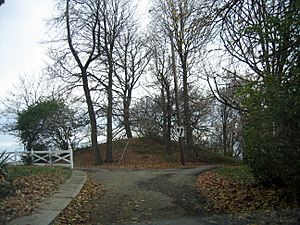
The first people in the Norwood area were from the ancient Adena culture. They lived here long before Europeans arrived. The Norwood Mound, a large earthwork built by the Adena, is still in Norwood today. It is listed on the National Register of Historic Places.
This mound is located in Norwood's Water Tower Park. This spot is the highest point in the city. Experts believe the Adena people built the mound here for religious ceremonies. They might have also used it to send smoke signals.
Many Native American mounds were once in Ohio. By 1895, the Norwood Mound was the only one left near Cincinnati. The mound has never been dug up by archaeologists. However, many artifacts found nearby by early settlers are now in the Cincinnati Art Museum.
How Sharpsburg Became Norwood
In 1787, the United States created the Northwest Territory. A man named John Cleves Symmes bought a large piece of this land. The future city of Norwood was part of this purchase.
In 1793, Anthony Wayne, a general, led troops through the area. They were fighting a Native American tribe. Historians think these troops widened an old Native American trail. This trail followed the path of today's Smith Road and Montgomery Road.
In 1794, Peter Smith settled near Duck Creek. He might have been the first settler in Norwood. Soon, roads were built connecting early settlements. These roads passed through what would become Norwood.
In 1809, Samuel D. Bowman bought land where two main roads crossed. He opened a tavern for travelers. John Sharp also built a cabin and a small store there. The small community of houses became known as "Sharpsburg," named after Mr. Sharp.
In 1866, the first train tracks were built through Sharpsburg. They ran from east to west. This new railway made people interested in building homes nearby. In 1868, the first train station opened in Sharpsburg.
In 1869, some developers bought land north of the railroad. They created a new neighborhood called Norwood Heights. This was the first time the name "Norwood" was used in the area. Many believe Sarah Bolles, one of the developers' wives, came up with the name.
Some say she got the name from a popular book called Norwood: or, Village Life in New England. Others think she combined "North Woods" because it was a wooded area north of Cincinnati. Either way, the name Norwood became very popular. In 1870, the Sharpsburg post office was officially renamed Norwood.
Trains and New Neighborhoods
Even with the new railroad, Norwood didn't grow quickly at first. It was still mostly farmland in the 1870s. The train route to Cincinnati was long and indirect. For Norwood to become a thriving suburb, it needed a direct train connection.
In 1875, local landowners worked with a railway company. They offered their land for free to build a direct passenger railroad. This new line would connect Norwood directly to downtown Cincinnati.
Around the same time, another railroad was built. It ran along the border of Norwood and Evanston. This line connected Norwood with Cincinnati's eastern suburbs.
In the early 1880s, both new train lines opened. This made it much easier to travel between Norwood and downtown Cincinnati. The trip took less than 20 minutes. This quick commute helped Norwood's population grow very fast.
Several train stations were built in Norwood. The Hopkins Station, located at 4226 Montgomery Road, is the only one still standing.
Becoming the Village of Norwood
The 1880s brought many improvements to Norwood. New neighborhoods were built. In 1882, the first Norwood Town Hall was constructed. It was a place for church services, meetings, and community events.
In 1887, a new school was built to handle the growing number of students. It was quickly expanded because so many children enrolled. By 1887, Norwood had about 3,000 residents.
In 1888, Norwood's first fire brigade was formed. Just six days later, they fought their first fire. The house they saved still stands today at 4243 Floral Avenue.
To keep improving the village, leaders decided to officially incorporate Norwood. On May 14, 1888, Norwood became a formal village. Dr. John C. Weyer was elected as the first mayor.
Norwood continued to grow by adding nearby land. In 1891, a new neighborhood called Elsmere became part of the village.
Local leaders also wanted an electric streetcar on Montgomery Road. This road was privately owned, and people had to pay a toll to use it. Norwood bought the road for public use.
In 1891, the Norwood Electric Railway streetcar line was finished. It connected Norwood to other areas. On July 4, 1891, Norwood celebrated the streetcar's opening with a huge party. Thousands of people came to ride the new streetcars.
By 1891, more schools were needed. Williams School and Marion School were built. These buildings were later replaced by newer ones that are still used today.
Getting clean drinking water was very important. In 1892, Norwood citizens voted to build a public "water works" system. This included wells, a pumping station, and a water tower. In 1894, the Norwood Water Works was completed. A 100-foot steel water tower was built near the Norwood Mound, where it still stands.
In March 1894, Norwood's first newspaper, the Norwood Enterprise, began publishing. It continued until 1989.
Norwood's first high school opened in 1897. It was an 8-room building. This was the first time Norwood offered a full four-year high school program. The high school building burned down in 1917, but the elementary school next to it still stands.
Early Businesses and Growth
In 1898, the Bullock Electric Manufacturing Company moved to Norwood. It became one of the city's first factories. This plant is now owned by Siemens and is still in operation.
In 1900, the Globe Wernicke Company built a factory in Norwood. They made wooden bookcases, which are now valuable antiques. In 1901, the United States Playing Card Company moved to Norwood. A year later, the American Laundry Machinery Company opened a factory.
Norwood Becomes a City
In 1902, Cincinnati tried to make Norwood part of its city. But Norwood citizens voted against it. Later that year, Norwood citizens voted to become a city. This was possible because their population reached 6,480.
In 1905, Norwood started its own Norwood Fire Department and Norwood Police Department. Also, the Andrew Carnegie Foundation provided money to build Norwood's first public library.
After two years of building, the Norwood Public Library opened in 1907. It was built on land donated by Edward Mills. This building is still used as a library today.
In 1908, Thomas and Nicholas Aglamesis opened an ice cream shop in Norwood. Their second store in Oakley, known as Aglamesis Brothers, is still a popular place in Cincinnati.
The same year, the United States Playing Card Company opened a large new factory in Norwood. It became the world's biggest maker of playing cards.
In 1912, Sears, Roebuck & Company bought a factory in Norwood. They changed its name to the Norwood Sash & Door Company. This factory made parts for Sears’ Catalog Homes. Sears operated the factory until 1945.
New Schools and City Hall
Norwood High School's student numbers kept growing. In 1914, a new high school was built on Sherman Avenue. This building is still used today as Norwood Middle School. The old high school became an elementary school.
Norwood's current city hall, the Norwood Municipal Building, opened in 1916. It is located at Montgomery Road and Elm Avenue. The building originally had a police station, jail, and an auditorium. It was added to the National Register of Historic Places in 1980.
In 1917, the old Allison High School building burned down. Firefighters worked for 22 hours to control the fire. The building was later rebuilt.
More than 3,000 fans watched the 1916 World Champion Norwood baseball team play at Norwood Park. This park was also used for circuses and other shows.
Industry and Infrastructure Growth
By 1919, Norwood had 47 factories. The city was a busy industrial hub.
In 1920, construction began on the Cincinnati Subway. The plan was for a 16-mile loop to connect downtown Cincinnati with Norwood. Several subway tunnels were built in Norwood. However, the project was stopped in 1928 due to money problems. One abandoned subway tunnel still exists in Norwood under Harris Avenue.
In 1922, General Motors bought land in Norwood to build a large car factory. This land was previously Norwood Park. The Norwood Assembly plant produced cars like the Chevrolet Camaro and Pontiac Firebird from 1923 to 1987. At its busiest, the GM plant employed nearly 9,000 workers. It also provided about 35% of Norwood's tax money.
To promote the game of bridge, the United States Playing Card Company started a radio station in 1922. In 1926, they added 12 carillon bells to their factory tower. The sounds of these bells were often broadcast on the radio.
In 1923, Norwood covered Duck Creek with a concrete tunnel. This allowed Duck Creek Road to be improved.
In 1930, Norwood changed its city council from four to six wards. This was because the city's population had grown.
Changes in Transportation and Businesses
In 1933, Norwood's last new passenger train station was built. The same year, the Cincinnati, Lebanon & Northern Railroad stopped offering passenger service. People were starting to use cars more often.
Albers Supermarket, the first supermarket in Ohio, opened in Norwood in 1933. It was located on Montgomery Road. This store introduced new ideas like shopping carts and individual pricing. The Norwood location burned down in 1968 and was not rebuilt.
In 1935, a swimming pool opened in Water Works Park. This project was partly funded by the Works Progress Administration during the Great Depression. The pool is still used today.
During the big Ohio River flood of 1937, Cincinnati's drinking water became dirty. Norwood helped by providing clean water from its wells. Norwood pumped millions of gallons of water a day to Cincinnati.
In 1940, the Lindner family opened the first United Dairy Farmers store in Norwood. They sold milk at a much lower price than home delivery. The UDF chain grew to over 200 stores.
In 1942, the General Motors Norwood Assembly Plant helped with the war effort. They made landing gear, bomb heads, and military trucks for World War II.
In 1948, Norwood opened a large parking lot. This was a step towards changing Norwood's downtown business area.
In 1949, streetcar lines in Norwood were replaced by trolley buses. The streetcar tracks were paved over in 1955.
In 1958, a memorial was dedicated in Victory Park. It honored Norwood veterans who died in World War I, World War II, and the Korean Conflict.
Around 1959, Norwood's wells became too expensive to maintain. Norwood began buying water from Cincinnati, which it still does today.
In 1962, the new Norwood Lateral Expressway was completed. To build this freeway, nearly 200 homes in East Norwood were torn down. This caused a loss of population and tax money for the city.
In 1964, the Globe-Wernicke Company moved out of Norwood. The factory was closed and torn down. GM bought the land for a parking lot.
In 1965, the overhead wires for trolley buses were removed. Gasoline and diesel buses replaced them.
Shopping Centers and Changes to "The Pike"
Around 1967, Norwood Plaza, Norwood's first strip mall, opened. Some business owners worried it would hurt the traditional downtown shopping area.
In 1968, after the Albers Supermarket burned down, Norwood bought the property. This was part of a plan to build a new shopping center called Surrey Square.
In 1972, the Plaza Theater and other businesses were torn down. This was part of the urban renewal plan. The Plaza was the last of Norwood's old movie theaters.
To handle more students, Norwood built a new high school in 1972. It included a television studio, swimming pool, and a planetarium. The old high school became the middle school. A new football stadium, Shea Stadium, was also built.
In 1975, Surrey Square Shopping Center opened. It was built in the heart of the old shopping district. The inside of the mall was designed to look like a traditional main street.
In 1985, Carl Lindner Jr. and his brother Robert Lindner donated money to Norwood. This helped the city buy the McCullough Estate. It was turned into a nature preserve and park. Norwood now has 9 city parks.
GM Factory Closes
On November 6, 1986, General Motors announced it would close the Norwood Assembly car plant. This was part of a big plan to reorganize the company. The Norwood plant was old and didn't have room to expand.
The plant's closure in 1987 was a huge blow to Norwood's economy. GM was the city's biggest employer. Its taxes made up one-third of the city's budget and one-fifth of school funding. About 1,000 Norwood residents worked at the factory.
Norwood City Council had to cut the city's budget. Many city employees were laid off. The school district closed an elementary school and laid off teachers. Norwood's parks, roads, and buildings began to suffer.
In 1988, another long-time factory, R. K. LeBlond Machine Tool Company, also closed. This meant another 250 jobs were lost.
The same year, Norwood celebrated its 100th anniversary as a village.
In 1989, Norwood's last newspaper, The Norwood Enterprise, stopped publishing. It had been in print since 1894.
Norwood's Comeback
Despite the tough times, Norwood saw the GM closure as a chance to change. The city wanted to become a place for businesses and shopping. In 1989, plans were made to develop the old GM site.
In 1990, a shopping plaza called Grand Central Station opened on the old GM plant site. It had stores, restaurants, and a movie theater.
In 1993, a new development called Central Parke opened. It had office buildings with lots of parking. This project was very successful because it offered lower rents than downtown Cincinnati.
Also in 1993, the Rookwood Pavilion shopping center opened. It was built on the site of the old Lablond factory. This outdoor mall was new for Cincinnati. It had big stores, specialty shops, and restaurants. Rookwood Pavilion was very popular.
In 2000, Rookwood Commons shopping center opened behind Rookwood Pavilion. This new outdoor mall had high-end stores and restaurants. It quickly became one of Cincinnati's top shopping spots.
In 2004, Norwood had to reduce its city council wards from six to four. This was because the population had declined. Norwood's population in 2000 was the smallest it had been in many decades.
Norwood also lost many bus routes in 2004. Some of these routes had served the city for over 100 years.
In 2004, another new development called Cornerstone At Norwood was built. It included office buildings.
Eminent Domain Case
After the success of the Rookwood shopping centers, the developer wanted to build a third project. It was called Rookwood Exchange. The plan was to tear down a small neighborhood of 79 houses and businesses. In their place, a new mixed-use development would be built. This project would bring a lot of money to Norwood.
The city approved the plan. The developer started buying properties. Most owners agreed to sell, but three refused. To get these properties, the city used eminent domain. This is when the government can take private land for public use, even if the owner doesn't want to sell.
The three property owners fought Norwood's use of eminent domain. The case went all the way to the Ohio Supreme Court in 2006. The court ruled in favor of the property owners. This meant the city and developers had to return the properties. The last property was sold to the developer in 2007.
More Recent Development
In 2006, construction began on Linden Pointe on the Lateral. This is a large office park. It was built on old factory sites that needed to be cleaned up first.
In 2008, the US Playing Card Company closed its factory in Norwood. They moved their operations to Kentucky.
Surrey Square shopping center was rebuilt and expanded. It added a large Kroger grocery store and other businesses.
In 2014, after many delays, Rookwood Exchange finally opened. It included restaurants, a hotel, and an office building.
Xavier University also opened University Station. This is a mixed-use development with housing for students, a bookstore, and restaurants.
Norwood's Location and Landscape
Norwood is located at 39°9′36″N 84°27′18″W / 39.16000°N 84.45500°W.
The city covers about 3.15 square miles of land.
The southern, eastern, and western parts of Norwood are mostly flat. But the northern half of the city has steeper hills. The highest point in Norwood is at the Norwood Mound in Tower Park. It is about 656 feet above sea level. This is one of the highest points in southwest Ohio. The ancient mound was likely built there because of the high elevation.
Near the mound are two large water towers. They were built in the 1800s to store water and control water pressure. In the early 1900s, people would visit the towers to climb their spiral staircases and see the views. Norwood helped Cincinnati during the Ohio River flood of 1937. Cincinnati's water was contaminated, so Norwood provided fresh water from its wells, stored safely in these towers.
Who Lives in Norwood?
| Historical population | |||
|---|---|---|---|
| Census | Pop. | %± | |
| 1900 | 6,480 | — | |
| 1910 | 16,185 | 149.8% | |
| 1920 | 24,966 | 54.3% | |
| 1930 | 33,411 | 33.8% | |
| 1940 | 34,010 | 1.8% | |
| 1950 | 35,001 | 2.9% | |
| 1960 | 34,580 | −1.2% | |
| 1970 | 30,420 | −12.0% | |
| 1980 | 26,126 | −14.1% | |
| 1990 | 23,674 | −9.4% | |
| 2000 | 21,675 | −8.4% | |
| 2010 | 19,207 | −11.4% | |
| 2020 | 19,043 | −0.9% | |
| Sources: | |||
Norwood's Population in 2020
In 2020, Norwood had 19,043 people. There were about 6,059 people per square mile.
Most residents (77.5%) were White. About 11.8% were Black or African American. Other groups included Asian (1.2%), Native American (0.3%), and Pacific Islander (0.1%). About 6.1% of people were of two or more races. About 5.8% of the population was Hispanic or Latino.
There were 8,543 households. About 18.5% of these households had children under 18. The average household size was 2.19 people.
About 16.7% of the population was under 18 years old. About 11.7% were 65 or older. The average age in Norwood was 32.5 years.
The estimated yearly income for a household was $48,703. For families, it was $71,066. About 21.6% of the population lived below the poverty line. This included 28.5% of those under 18. About 67.5% of the population was employed.
Norwood's Economy
Norwood has a long history of industry and manufacturing. It was once called the "Chicago of Hamilton County." This was because it had many factories. Norwood's location near major railways and highways made it a good place for businesses.
Some important companies in Norwood's history include:
- General Motors Norwood Assembly
- United Dairy Farmers
- Siemens
- Bullock Electric Manufacturing Company
- United States Playing Card Company
- Globe Wernicke
- American Laundry Machine Company
- Norwood Sash & Door Company (Sears Catalog Homes)
The General Motors car plant was Norwood's biggest employer for many years. When it closed in 1987, it greatly affected Norwood's economy. This event led Norwood to change its focus. It moved from being an industrial city to a place for offices and retail.
After the GM closure, Norwood worked with developers. They built many new office parks and shopping centers. These include:
- Grande Central Station (1990)
- Central Parke (1993)
- Rookwood Pavilion (1995)
- Rookwood Commons (2000)
- Cornerstone at Norwood (2004)
- Linden Pointe on the Lateral (2007)
- Surrey Square (2008)
- Rookwood Exchange (2014)
Learning in Norwood
The Norwood City School District includes:
- Norwood High School
- Norwood Middle School
- Sharpsburg Elementary
- Norwood View Elementary
- Williams Avenue Elementary
- Norwood Preschool
The current high school opened in 1972. It was a very modern building for its time. It had a planetarium, a greenhouse, a swimming pool, and a television studio. The Drake Planetarium is named after a famous astronomer. Norwood High School's mascot is the Indian.
Norwood Middle School is next to the high school. It is in the building that was the high school from 1914. Norwood is also home to Immaculate Conception Academy, a private school.
Fun and Games in Norwood
Norwood Recreation Commission
The Norwood Recreation Commission helps organize fun activities for the city. It was started in 1943. It works with both the city and the school board.
The commission runs four playgrounds and three swimming pools in the summer. They also help organize leagues for softball and soccer teams.
Swimming pools (some are now closed):
- Burwood Pool (closed)
- Fenwick Pool (closed)
- Millcrest Pool (closed)
- Northwoods Pool (closed)
- Norwood High School Pool
- Norwood Middle School Pool (closed)
- Victory Pool (closed)
- Waterworks J.B. Wirth Pool
Parks:
- Burwood Park
- Dorl Park
- Fenwick Park
- Hunter Park
- Lindner Park Nature Preserve
- Marsh Park
- Millcrest Park
- Lower Millcrest Park
- Northwoods Park
- Tower Park
- Victory Park
- Waterworks Park
What is Norwood Called?
Norwood is known as the "Gem of the Highlands."
Famous People from Norwood
Many interesting people have connections to Norwood, Ohio.
Arts and Entertainment
- George Chakiris, actor and dancer
- Henry Farny, French-born painter
- Tim Lucas, novelist and film critic
- Mr. Dibbs, hip hop producer
- Jack Mullaney, actor
- Over The Rhine, Ohio folk music band
- Jody Payne, musician
- Janice Rule, actress
- Amanda Tepe, actress
- Vera-Ellen, actress and dancer
Business Leaders
- Samuel Frisch, who opened the first Frisch's Big Boy restaurant
- Carl Lindner Jr., a well-known banker and financier
Science and Medicine
- Brian Werner, tiger conservationist
- John Uri Lloyd, pharmacist and scientist
Sports Stars
- Bob Barton, baseball player
- Carl Bouldin, baseball pitcher
- Marc Edwards, football player
- Dorothy Kamenshek, baseball player
- Ed Jucker, basketball coach
- Maxwell Holt, volleyball player
- Brian Pillman, football player
- Dominique Steele, mixed martial artist
Religious Figures
- Ralph W. Beiting, founder of the Christian Appalachian Project
- Joseph R. Binzer, a bishop in the Archdiocese of Cincinnati
- Robert Daniel Conlon, a bishop in the Diocese of Joliet
- Henry K. Moeller, Archbishop of Cincinnati from 1904 to 1925
Images for kids
See also
In Spanish: Norwood (Ohio) para niños



